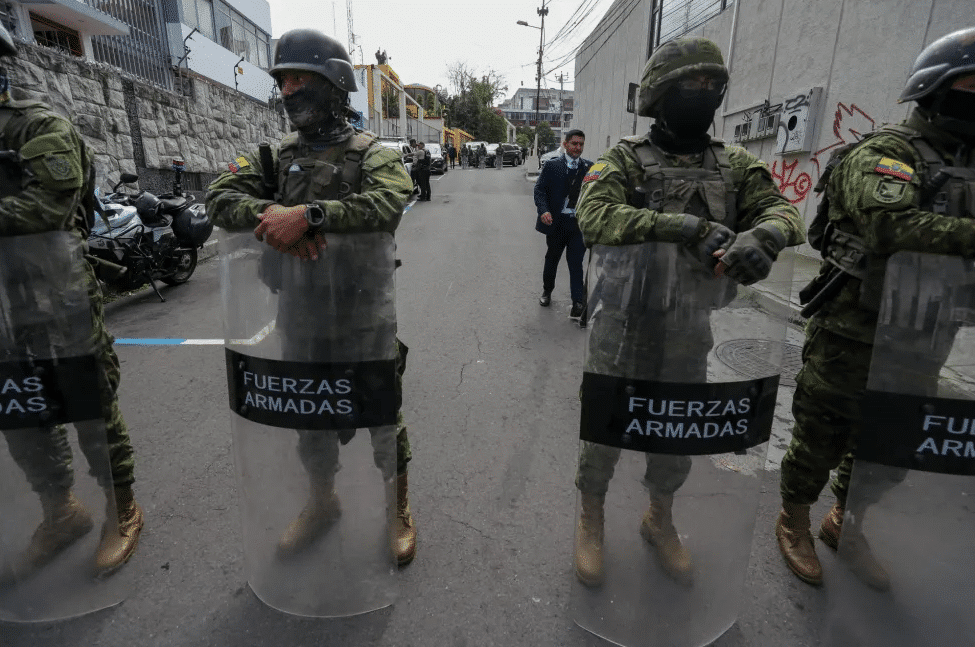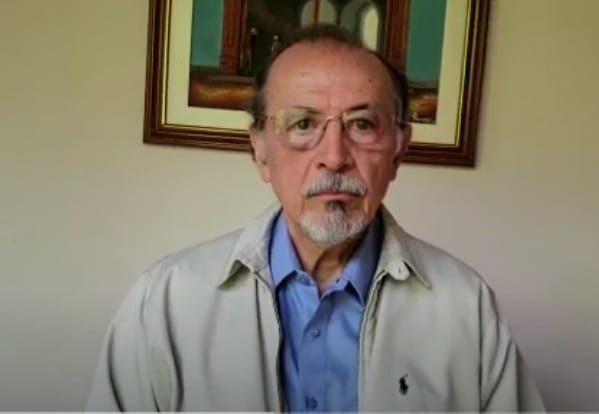17 de enero 2022

The Return of the Military

PUBLICIDAD 1M
PUBLICIDAD 4D
PUBLICIDAD 5D
He has never given in to power and when Ortega regained the government in 2007, he did not accept positions, perks, or privileges.

asegura en esta entrevista.
Today we will be heroes or martyrs,” said the legendary Germán Pomares when Eduardo Contreras, head of the commando, confirmed to them: “It is today and there is no turning back!” It was December 27, 1974, and, indeed, Hugo Torres Jimenez became a hero, not only for his participation in the commando operation to seize Chema Castillo’s house, but for all the years of his guerrilla life in the struggle against Somoza and his belligerent military leadership in the spectacular assault on the National Palace.
Hugo Torres has never given in to power and when Ortega regained the government, he did not accept positions, perks or privileges. Today, he is the only former general of the National Army who is active in continuing the struggle for democracy in Nicaragua. And with his example, from the regime’s dungeon, the former head of the Political Directorate of the Sandinista Popular Army (EPS), is setting the path to be followed by his former comrades in arms and by all those who refuse to surrender and live like slaves.
Hugo was born in 1948, in El Espino, Madriz. When he was five years old, his family moved to Leon, where he lived and studied, and he has always considered himself from Leon. Until he went underground, he lived in the El Calvario neighborhood, near where Rigoberto Lopez Perez lived, whom he met before he executed Somoza García in 1956. His mother was Isabel Jimenez and his father, Cipriano Torres, a second lieutenant in the National Guard (GN).
In 1971 he joined the FSLN and in July 1974, without finishing his law studies, he went underground. He immediately went to the military and political training school at the “El Panama,” farm of the Sandinista collaborator Yico Sanchez, in Jinotepe, Carazo.
When he was chosen to be part of the “Juan José Quezada” Commando, he spent months in seclusion and training until they carried out the Diciembre Victorioso (Victorious December) operation, in which they kidnapped high officials of the Somoza government who were attending a party at Chema Castillo’s house. The commando demanded the release of the political prisoners of that time. They achieved their objectives in less than 48 hours. Afterwards, they flew to Havana with the rescued political militants, among them Daniel Ortega, today his tormentor and current illegitimate president of Nicaragua.
In 1975, he clandestinely entered Nicaragua through trails from Hondurans, accompanying Carlos Fonseca. He was put in charge of Chinandega for a short time, because in January 1976 he entered the mountains in a contingent led by Carlos Aguero Echevarria.
He was integrated into the central camp of the “Pablo Ubeda” Brigade, commanded by Henry Ruiz (Modesto), deep in the Isabelia mountain range. He lived the harshness of the mountains in the time he called the “lean cows,” when the peasant population was subjected to brutal repression, registering more than 3,000 disappeared. This forced the locals to leave the mountains and settle near the centers of operation of the National Guard, leaving the guerrillas without collaborators, at the mercy of hunger and illnesses. Hugo went days and days without food, resorting to tubers, monkey meat and banana peels. There he suffered from leishmaniasis, the dreaded mountain leprosy of the guerrilla fighters.
At the end of 1976 he participated in several defensive battles. In March 1977 he was chosen to join the “Aurelio Carrasco” squadron, an offensive unit under the command of Carlos Aguero, which would attack National Guard patrols that pursued guerrilla fighters and repressed peasants. The first action was the attack on the patrol located in Lisawe, an operation in which Carlos Aguero was killed. Hugo has recounted that Aguero’s death, the fierce siege carried out by the National Guard, the lack of food and medicines, the battles s in which several combatants were killed or wounded, plus other problems, caused the disintegration in the morale and unity, so some decided to leave for the city.
Commanding one of these groups, with the purpose of reaching Honduras, Hugo began the arduous march after the combat of August 13. In January 1978, they reached Rio Patuca, a tributary of the Rio Coco, in Honduran territory. Torres remembers it because there he heard the news of the assassination of Pedro Joaquín Chamorro Cardenal. He contacted the FSLN organization in Honduras, already divided into tendencies, and joined the “tercerista” (insurrectional tendency) forces.
In mid-1978 he re-entered Nicaragua and was selected to integrate the “Rigoberto López Pérez” Commando, which carried out the “Operación Muerte al Somocismo” (Operation Death to Somocism) or assault to the National Palace. Another spectacular action that allowed the liberation of more than sixty political prisoners. He was second in command of the operation, in which Dora María Téllez also participated, as political and negotiation leader. Hugo is the only one who participated in the two most awesome commando operations carried out by the FSLN.
When the revolution triumphed, he was distinguished by the honorary degree of guerrilla commander and appointed vice-minister of the Interior. When he was integrated to the Council of State he was transferred to the Army and was appointed its representative to this State power which functioned as legislative body. In 1982 he was awarded the Carlos Fonseca Order, the highest distinction of the FSLN, given at that time to a small group of Sandinistas, in recognition of exceptional merits.
He was a member of the Sandinista Assembly until 1990 and was responsible for political training of soldiers and officers as head of the Political Directorate of the EPS. In the National Army he obtained the degree of Brigadier General, with which he went into retirement in the mid-1990s.
Since his return to civilian life, Hugo expressed his criticism of the party leadership, then dominated by Daniel Ortega and rapidly moving towards a pact with right-wing Arnoldo Aleman. I remember Hugo in the days when he interacted with groups critical of the emerging Ortega takeover, expressing his concern about the authoritarian drift and the risks that it meant for democracy in Nicaragua. At that time, he did not participate in any political party.
He was aware of the importance of the recovery of historic memory, and when I invited him to my radio interviews program to talk about Diciembre Victorioso he said to me:
“I consider this program very important because history is a reference of the first order, extremely important, indispensable to be able to live the present and to be able to plan the future. Unfortunately, we forget about it and that is why we stumble again over the same stone. Because of that, I consider this retrieval of history that is made in your program to be fundamental.”
For this reason, on several occasions, when my occupations forced me to be out of the country, Hugo became the interviewer in our program.
His concern for memory made him write his testimonial book Rumbo Norte (Heading North): History of a Surviver, prologue by Sergio Ramírez and presented in the auditorium of the National Palace, in the same site where he, rifle in hand, participated in the afore-mentioned action. He also published a book of poetry “Coplas y algunos poemas infiltrados” (Couplets and some infiltrated poems). The couplets, he said, were a remembrance of those he recited in Leon accompanying the dances of the “gigantona” (carnival female giant) and the “enano cabezon” (big-headed dwarf).
Like many of us, Hugo Torres’ break with the FSLN was based on positions of principles. When his civilian status allowed it, he rejected the pact with Aleman and corruption through declarations. Since then, he has been a visible figure in the political life of Nicaragua and a source of information, especially when analyzing issues related to the Nicaraguan Army. In the 2008 municipal campaign he joined the MRS (Sandinista Renovation Movement), in which that party did not participate directly because its legal status was illegally and arbitrarily taken away.
In the 2011 national campaign, Hugo participated in the MRS-PLI alliance and was elected deputy to the Central American Parliament. In the VIII National Convention of the MRS (18/11/2017), he was elected vice president of that organization, next to Suyen Barahona Cuan, president, a position he kept when in the IX Convention, held in January 2021, the MRS party became the Renovation Democratic Union (UNAMOS).
During the 2018 popular uprising, Hugo Torres continued giving press conferences, interviews and writing opinion articles, exposing, and denouncing the dictatorial nature of the Ortega-Murillo regime. He also participated in marches and other civic expressions of rejection of the government’s policies, repeating again and again that this time the struggle will have to be within civic channels.
On June 13, 2021, he was kidnapped by the Ortega-Murillo dictatorial regime. In anticipation of his capture, minutes before his arrest, he recorded a video where he recalled his participation in the struggle against Somoza.
“I am 73 years old. I never thought that at this stage of my life I would be fighting against a new dictatorship (…), but that is how life turns. Those who once embraced principles in favor of justice, in favor of freedom, today have betrayed them and today are their main enemies” …And he closed by saying: “Courage, people, (we must) keep our spirits high, because history is on our side. ¡De que se van, se van! (They will go, they will go!).“
At the time of writing these notes it is public that on December 17, 2021, Hugo Torres was taken out of the cell he shared with other prisoners in El Chipote; that during the last weeks he had fallen ill rapidly and that his companions had to help him several times, because, due to the degree of inflammation of his legs, he was almost unable to move on his own. He was treated by prison doctors, but they were unable to alleviate his condition. On that day, Hugo suffered a long fainting spell. He was taken out of his cell to an unknown destination.
Neither the Police Complex authorities nor the high command of the Police, much less the illegitimate Government of Nicaragua, have clarified the situation of the guerrilla commander, retired Brigadier General Hugo Torres, hero of the fight against the Somoza dictatorship and, undoubtedly, of this civic and peaceful struggle against the Ortega regime.
To tell his story and claim with righteous anger information about his situation, is my right and my duty, because Hugo does not only belong to his biological family; he also belongs to the struggle of a people against oppression and dictatorships.
This article was originally published in Spanish in Confidencial and translated by Havana Times
Archivado como:
PUBLICIDAD 3M
Guerrillera, revolucionaria y política nicaragüense. Participó en la insurrección contra la dictadura somocista. Exdiputada de la Asamblea Nacional. Fundó el disidente Movimiento por el Rescate del Sandinismo. Tiene una licenciatura en Ciencias Sociales y una maestría en Derecho Municipal de la Universidad de Barcelona, España. Es autora de la serie "Memorias de la Lucha Sandinista".
PUBLICIDAD 3D